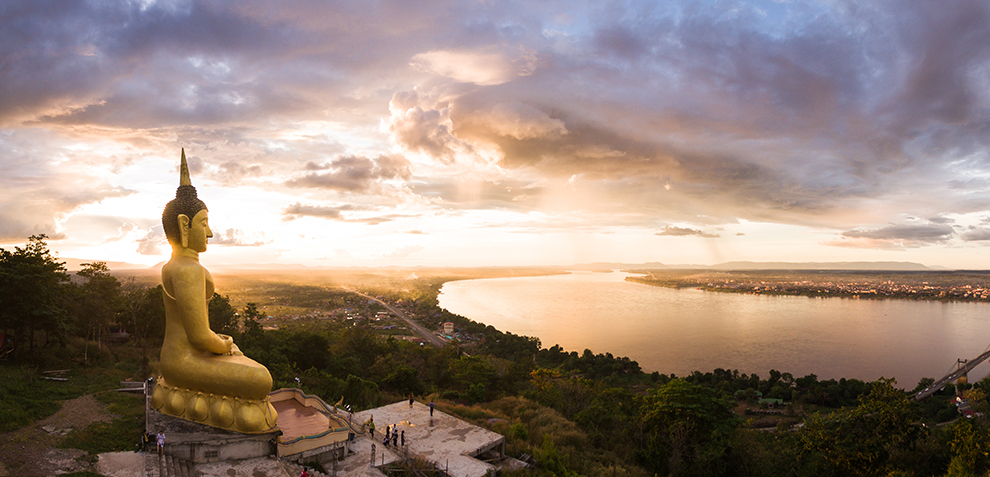













Embark on a journey through Laos, delving into remarkable historical landmarks that span from the awe-inspiring ancient marvels of the Plain of Jars and pre-Angkorian temples to the perpetuated modern-day history encapsulated within the Vieng Xai Caves. Enrich your experience with Laotian cultural endeavors, all set against a backdrop of exceptional natural beauty.
Brieft Itinerary:
Day 1: Pakse Arrival
Day 2: Pakse – Bolaven Plateau | Coffee Plantations and Dramatic Waterfalls
Day 3: Pakse – Don Khong | Ancient Khmer Temples and Southeast Asia’s Largest Waterfalls
Day 4: Don Khone – Vientiane | Explore the Mekong’s ‘4,000 Islands' Archipelago
Day 5: Vientiane | City Tour
Day 6: Vientiane – Xiang Khoang – Phonsavan | Explore a Megalithic Archaeological Landscape
Detailed Itinerary:
Day 1: Pakse Arrival
Upon reaching Pakse, the capital of Champassak Province, you'll find yourself in southern Laos, nestled near the Thai border at the convergence of the Mekong and Se Don rivers. The colonial imprints on Pakse are most evident in its historic riverside old quarter. Spend the remainder of your day at your riverside lodge situated on the delightful, car-free island of Done Daeng, often referred to as the "Red Island". Unwind on the white sand beach along the Mekong, with a captivating view of the picturesque Vat Phou temple (Wat Phu). Immerse yourself in the extraordinary natural beauty and untouched allure of southern Laos.

Day 2: Pakse – Bolaven Plateau | Coffee Plantations and Dramatic Waterfalls
Stretching across the landscape, the Bolaven Plateau, an expansive highland sculpted by an ancient volcano, captivates with its abundant green jungles, winding rivers, picturesque farmlands, and a mosaic of diverse ethnic communities. Dedicate your day to unraveling the charms of this naturally stunning elevated region with a refreshing and cool climate.
Embark on a journey through celebrated tea and coffee plantations that flourish in the fertile volcanic soils of the highlands. The coffee beans cultivated in this area are esteemed for their premium quality. Along the way, make stops at awe-inspiring waterfalls, some cascading into breathtaking 200m (656ft)-high ravines, adding a touch of drama to the already spectacular scenery.

Day 3: Pakse – Don Khong | Ancient Khmer Temples and Southeast Asia’s Largest Waterfalls
Built between the 6th and 13th centuries, the pre-Angkorian Vat Phou temple (Wat Phu) stands as a testament to the grandeur of the Khmer Empire, intricately connected to Cambodia's Angkor Wat through ancient highways. Recognized as the birthplace of Khmer Hindu architecture, this charming Hindu temple complex has earned its place as a UNESCO World Heritage Site. Immerse yourself in the exploration of the mythical temple ruins and weathered structures, uncovering the historical richness within.
Venture onward to the Khone Pha Pheng Falls, a staggering 10km (6mi) stretch of cascades, marking Southeast Asia's largest waterfalls and one of Laos' most remarkable natural wonders. Listen to the thunderous roar and witness the awe-inspiring power generated by millions of liters of water crashing over rocks, creating a mesmerizing spectacle.

Day 4: Don Khone – Vientiane | Explore the Mekong’s ‘4,000 Islands' Archipelago
Discover the enchanting Si Phan Don, also known as 'The 4,000 Islands,' a cluster of mostly uninhabited islands scattered across a 14km (8.5mi)-wide, meandering stretch of the Mekong River. Board a traditional long-tail boat to cruise through the Si Phan Don riverine archipelago, navigating south of Don Khong, the largest inhabited island in this archipelago. Immerse yourself in the tranquility of this rural haven where locals lead simple lives. Once a modest 19th-century French Indochina settlement, Don Khone still preserves remnants of its colonial past, including an old French railway station.
Continue your journey to the magnificent Liphi Waterfalls, affectionately known as the "Corridor of the Devil," serving as a natural boundary between Laos and Cambodia and a habitat for freshwater dolphins. In the afternoon, arrive in Vientiane, Southeast Asia's smallest capital city. Nestled along the Mekong River, close to the Thai border, this former French Indochina trading post emanates a laid-back ambiance and exudes old-world charm.

Day 5: Vientiane | City Tour
Immerse yourself in a captivating day of exploration, uncovering some of Vientiane's most significant landmarks and historic structures. Begin at Wat Sisaket, one of the capital's oldest surviving temples, renowned for its iconic cloister wall that houses thousands of diminutive Buddha images.
Venture into downtown Vientiane to witness the grandeur of That Luang, a remarkable 44m (147ft)-high Buddhist stupa adorned with golden coverings, recognized as the nation's most pivotal monument. Marvel at its architectural splendor and soak in the spiritual ambiance that surrounds this revered site.
Make a stop at the iconic Patuxai Victory Monument, reminiscent of an Arc de Triomphe, embellished with Lao mythical designs. Dedicated to those who fought in the struggle for independence from France, this monument stands as a testament to the nation's history and resilience.

Day 6: Vientiane – Xiang Khoang – Phonsavan | Explore a Megalithic Archaeological Landscape
Spread across the undulating terrain of the Xiang Khoang Plateau, the mysterious "Plain of Jars" stands as one of Southeast Asia's paramount prehistoric sites. This megalithic archaeological landscape boasts approximately 2,500 sandstone jars arranged in clusters across an extensive area. Varying in height from 1m to 2.5m (3ft to 8ft), these colossal jars, believed to be 1,500-2,500 years old, trace their origins back to the Southeast Asian Iron Age. Despite intensive archaeological study, the precise purpose of these ancient cylinders remains shrouded in mystery, though most likely linked to prehistoric burial practices.
The historical significance of the Plain of Jars is tinged with the unfortunate legacy of the so-called "Secret War" when the area was heavily bombed by US forces during the 1960s and 1970s. As a consequence, the countryside is now littered with thousands of unexploded ordnance. If time allows, a visit to the Mine Advisory Group is on the itinerary. This group is engaged in a project to render the area safe from the risks posed by the remnants of unexploded ordnance, highlighting the lasting impact of past conflicts on the region.
